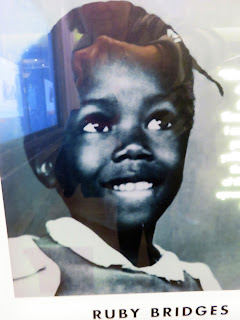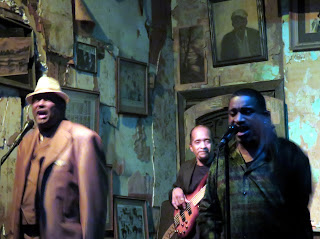 |
| Dr. King was standing on the balcony behind Jim and me when he was killed |
On
April 4, 1968, (50 years ago today)
Dr. Martin Luther King was fatally shot by an assassin while he stood on the second story balcony of the Lorraine Motel. Dr. King was
in Memphis in solidarity with sanitation workers who were protesting unsafe working
conditions and unfair wages.
Because these workers made less than $1/day, they could ill afford missing
their paychecks during a strike. But,
after two men were crushed by a malfunctioning garbage truck, they went out. Ten thousand tons of garbage piled
up as they protested. On their first march, they were attacked by
police. At their second march, hundreds
were arrested, and a 16-year old boy – Larry Payne – was shot and killed. Martin Luther King joined them for their third
march, where they carried signs simply proclaiming “I
Am A Man.”
 |
Many
pled with Dr. King not to go to Memphis.
He was in the throes of planning a huge Poor People’s Campaign March on Washington. (After the earlier march on Washington - where Dr. King gave his "I Have a Dream" speech - and action re: racial equality had resulted, he broadened his human rights agenda to include economic
equality and an end to poverty. The Poor
People’s March was to be a main vehicle.)
His friends also urged him not to go to Memphis because of threats against his
life. But, King felt compelled to go to show his support for the garbage workers. He said, “Whenever
you are engaged in work that serves humanity, it has dignity. For the person who picks up our
garbage, in the final analysis, is as significant as the physician. … All labor
has worth.” (MLK, March 18, 1968)
So, on
April 3, he arrived in Memphis. That
evening, a rally was held at Mason Temple.
Dr. King had not planned to go. At the last minute, he was telephoned at the motel and asked to come, as an overflow crowd was at the Temple hoping to hear King speak. He went – and it was there that he gave his “I Have Been to the Mountaintop” speech. If you read that speech now, it appears to foretell
his impending death.
 The
next day at the motel, he continued planning the Poor People’s
campaign. That evening, he and his companions stepped out of room 306 to go to dinner. He
leaned over the balcony railing, and asked musician Ben Branch to play his
favorite hymn “Precious Lord” at that
evening’s meeting. His last words were:
“Please play it pretty.”
The
next day at the motel, he continued planning the Poor People’s
campaign. That evening, he and his companions stepped out of room 306 to go to dinner. He
leaned over the balcony railing, and asked musician Ben Branch to play his
favorite hymn “Precious Lord” at that
evening’s meeting. His last words were:
“Please play it pretty.”
At 6:01 p.m., a single bullet fired from
across the street hit him in the neck. He died an hour later. He was not yet 40 years old.
 |
| Dr. King lies shot on the floor The others are pointing to the gunman's location |
 |
| Room 306 has been preserved as it was the day Dr. King died |
Today,
the Lorraine Motel is home to the National Civil Rights Museum, which was
America’s first civil rights museum.
Room 306 – where King spent his last hours, remains as it was on the
day he died, down to the unmade bed where he took an afternoon nap, and
cigarette stubs left in the ashtray.
The
museum has been built around that room – and continues across the street to include the boarding house from which the bullet was fired.
Hands down, the Lorraine Motel was Jim and my favorite museum. While
the others we visited told gripping personal stories, most focused on the 1950s and 1960s. This one covered 400 years of
history from pre-Revolutionary times onward - including the Middle Passage slave ships, the promise of Reconstruction, the backlash of Jim Crow laws, all the way to
today’s Black Lives Matter. Jim especially liked that the exhibits were packed with facts. These were some that made me stop and gasp:
- In 1760, one male slave could be purchased for 6 ounces of gold, or the equivalent of 2 muskets, 5 bolts of cotton cloth, 20 pounds of seashells, or 40 pounds of gunpowder. This was what “the marketplace” determined was the cost of someone’s life!
- Approximately one-fourth of all human “cargo” died on the voyage across the Atlantic. However, ship captains held insurance to cover the cost of these lost “goods,” so they were paid either way.
- Slavery in America lasted for 250 years, which equates to 13 generations! I had never thought of it in terms of generations of mothers, fathers, and kids who were bought and sold.
- The “value” of enslaved people to their “owners” at the beginning of the Civil War is estimated to be $3 billion --- more than the value of all railroads, banks and manufacturing combined!
- During Reconstruction, more than 1400 African Americans held elective office in the South. After Jim Crow laws were passed, one hundred years went by before there were again that many elected Black officials.
- The sheer number of lynchings that occurred in a thirty-year span, including three in Duluth, Minnesota. Here’s the map:
 |
| A red dot represents a person lynched (1900-1930) |
Another
exhibit that drew me in concerned school desegregation. I’ll mention here just one girl named Ruby Bridges. She was the first very brave Black child to enroll and integrate a New Orleans public
school. She spent the entire year as the
only child in her class because white parents refused to let their children
attend class with her. She also wasn't allowed to play on the playground. Ruby was 6 years
old!
 |
| Rockwell called this painting: "The Problem We All Live With." |
Last, I started this post saying that “an assassin” killed Dr. King. A final exhibit questions whether James Earl Ray actually killed Dr. King – and/or whether he
acted alone. Church members at Dexter Avenue Baptist Church in Montgomery first told us the King family
absolutely believes that “others” were behind the killing, including possibly
our own government. The Lorraine Motel exhibit just
hangs a few curiosities out there for you to consider, such as:
- James Earl Ray was an unemployed, ex-con drifter, yet he fled the country with four different doctored identities. He eluded an extensive manhunt for 65 days, flying to five different countries before he was arrested. If he acted alone, how could he have afforded this? Leading up to the killing, his only employment on record earned him $664.34 as a dishwasher in Chicago.
- Dr. A.D. King – Martin’s brother - struggled to understand his brother’s killing and pledged to explore it. Before he could do so, his body was found drowned. His family members believe he was murdered: “Absolutely, he was murdered. He was an excellent swimmer. There was no water in his lungs. He had a bruised forehead. Rings around his neck. And he was in his underwear.”
- James Earl Ray recanted his guilty plea, and insisted he did not fire the killing shot. Dr. King's son went to see Ray in prison as he was dying, and left convinced that Ray was telling the truth.
Whether
Dr. King was murdered by a solo actor or unnamed others, what is clear to me is that we lost someone who may have helped us get to a
better place than we have - fifty years later. From his “Mountaintop”
speech envisioning a world where no one is judged by the color of her skin, to
his stance against wars, to his personal stands against injustice, to his strict adherence to non-violence, to his final writings urging us to tackle poverty - all underscore the loss of this rare and visionary leader.
Today – April 4, 2018, at 6:01 p.m. Central Time, the exact time that King was shot – bells are supposed to toll nationwide to commemorate the 50th anniversary of his death. Whether or not you are in an area where the bells will ring out, I hope you will mark his passing with a moment’s observance of your own. I know that I plan to.



















